
Nepenthes mirabilis, or the common swamp pitcher-plant and tropical pitcher plant, is a carnivorous plant species. By far the most widespread of all Nepenthes, its range covers continental Southeast Asia and all major islands of the Malay Archipelago, stretching from China in the north to Australia in the south. The species exhibits great variability throughout its range. One of the more notable varieties, N. mirabilis var. echinostoma, is endemic to Brunei and Sarawak and possesses an extremely wide peristome.
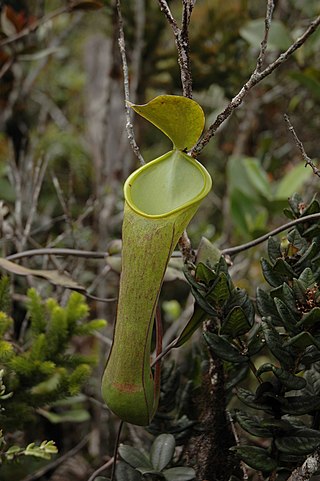
Nepenthes murudensis, or the Murud pitcher-plant, is a tropical pitcher plant endemic to Mount Murud in Borneo, after which it is named. It is of putative hybrid origin: its two original parent species are thought to be N. reinwardtiana and N. tentaculata.
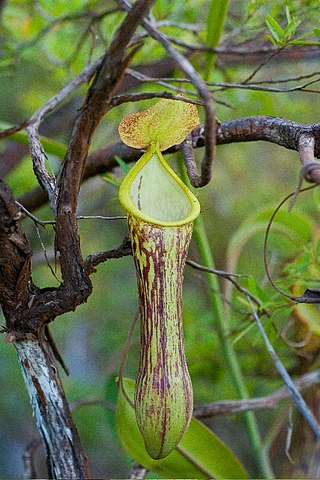
Nepenthes mindanaoensis is a tropical pitcher plant native to the Philippine islands of Mindanao and Dinagat.

Nepenthes petiolata is a highland Nepenthes pitcher plant species endemic to Mindanao island in the Philippines, where it grows at an elevation of 1,450–1,900 metres (4,800–6,200 ft) above sea level.

Nepenthes smilesii is a tropical pitcher plant native to northeastern Thailand, southern Laos, Cambodia, and Vietnam. Nepenthes smilesii can tolerate an extended dry season and is most common in open, sandy savannah and grassland.
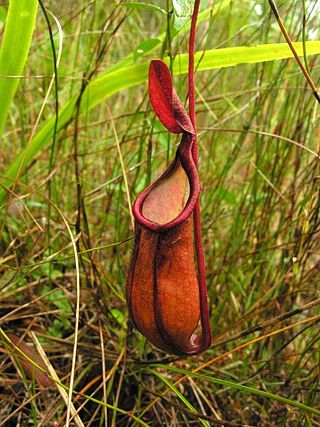
Nepenthes kampotiana is a tropical pitcher plant native to southern Cambodia, eastern Thailand, and at least southern coastal Vietnam. It has an altitudinal distribution of 0–600 m above sea level. The specific epithet kampotiana refers to the Cambodian city of Kampot, close to which the first specimens of this species were collected.
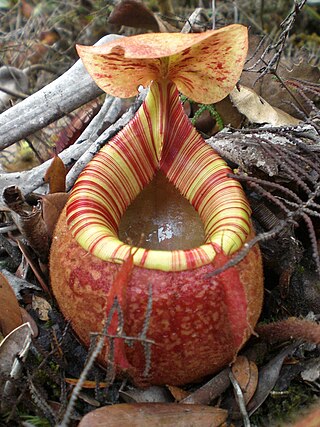
Nepenthes peltata is a tropical pitcher plant known only from the upper slopes of Mount Hamiguitan on the island of Mindanao in the Philippines. It is characterised by a peltate tendril attachment and conspicuous indumentum. The species typically produces ovoid pitchers with a prominent basal crest and large nectar glands on the lower surface of the lid.

Mount Hamiguitan is a mountain located in the province of Davao Oriental, Philippines. It has a height of 1,620 metres (5,315 ft). The mountain and its vicinity has one of the most diverse wildlife populations in the country. Among the wildlife found in the area are Philippine eagles and several species of Nepenthes. Some of the latter, such as the Nepenthes peltata and Nepenthes micramphora, are endemic to the area. The mountain has a protected forest area of approximately 2,000 hectares. This woodland is noted for its unique pygmy forest of century-old trees in ultramafic soil, with many endangered, endemic and rare species of flora and fauna.

Nepenthes micramphora is a tropical pitcher plant known only from Mount Hamiguitan on the island of Mindanao in the Philippines. It is a highland plant growing at elevations of 1100–1635 m.

Nepenthes nigra is a tropical pitcher plant known from a number of mountains across Central Sulawesi, where it grows at elevations of 1,500–2,700 m (4,900–8,900 ft) above sea level. The specific epithet nigra refers to the dark colouration of the pitchers and stem. The species is closely related to N. hamata and N. tentaculata.
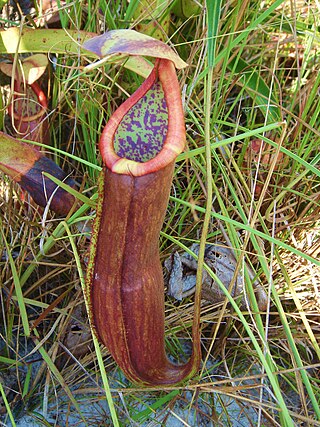
Nepenthes kongkandana is a tropical pitcher plant endemic to Songkhla Province in southern Thailand. It is closely related to N. kerrii.
Volker Bernd Heinrich is a German naturalist.

Nepenthes andamana is a tropical pitcher plant endemic to Phang Nga Province, Thailand, where it grows near sea level in coastal savannah and grassland. It is thought to be most closely related to N. suratensis.
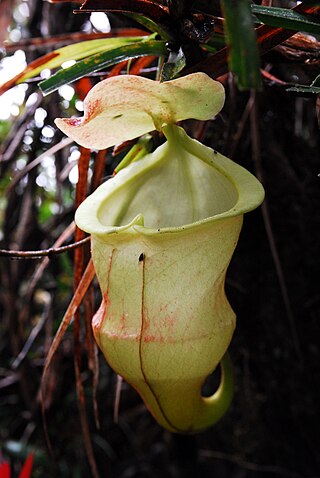
Nepenthes hamiguitanensis is a tropical pitcher plant endemic to a single peak on the Philippine island of Mindanao, where it grows at elevations of 1200–1600 m above sea level. Once thought to be a natural hybrid between N. micramphora and N. peltata, this plant is now considered a species of possible hybridogenic origin. It produces squat upper pitchers that vary greatly in pigmentation, from red speckled to yellow throughout.

Nepenthes monticola is a tropical pitcher plant known from a number of mountains in the west central highlands of western New Guinea, where it grows at elevations of 1400–2620 m above sea level. Prior to its description as a species in 2011, N. monticola was lumped with the closely related N. lamii.

New Nepenthes: Volume One is a reference work by Stewart McPherson on the pitcher plants of the genus Nepenthes. It was published in 2011 by Redfern Natural History Productions and focuses on discoveries made since the release of McPherson's 2009 monograph, Pitcher Plants of the Old World. The book was edited by Alastair Robinson.

Nepenthes justinae is a tropical pitcher plant known only from Mount Hamiguitan on the Philippine island of Mindanao, where it grows at elevations of 1000–1620 m above sea level.
















